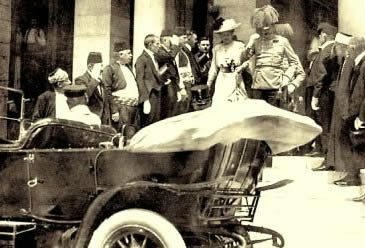First War and technoscientific development
THE First World War it is considered by many historians to be the most catastrophic event in recent times. This is because the rupture that this war provoked with the entire civilizational structure before it was unprecedented. Equally unprecedented was the death toll, as well as the destructive impact it caused.
O advancetechnoscientific applied to industrywar contributed a lot to this devastating potential. Bombs, machine guns, mortars and chemical weapons such as mustard gas (or expert), were among the technological inventions employed with deadly efficiency in World War I. But other inventions, in the field of transport, were also quite impactful, such as the plane and armored combat vehicles, which became known as “war tanks”. O first of those tanks to enter combat was the British Mark I.
Armored combat vehicle prototypes
The first armored combat vehicles were developed in the early years of the 20th century as models of common, four-wheeled cars such as the
Rolls Royce, clad in metal armor and armed with machine guns. One of these cars was the German Austro-Daimler Panzerwagen, 1904. However, these models were not fully applied in the first months of World War I, as they did not have the characteristics necessary for objectives such as: overcoming obstacles, both natural and built, and being armed with artillery heavy: cannons.From "Little Willie" to "Mark I"
Starting from the armored Rolls Royce model, from Royal Naval Air Service, manufactured in 1914, the then Lord of the British Admiralty, winstonChurchill, who would later become prime minister of England, authorized a project entitled LandshipsCommittee to produce a new prototype of a British tank. Unlike previous models, this prototype, tested on September 6, 1915, was no longer an adaptation of an ordinary combat car, but the creation of a specific war car. The name received was “littleWillie” and, instead of four wheels, it had two metal crawlers (like those on tractors), also armored vehicles, which allowed better locomotion through steep places and more resistance to attacks enemies.
Do not stop now... There's more after the advertising ;)
The “Little Willie” paved the way for increasingly resistant and dynamic models. The most efficient of these models, Mark I, was taken into combat on September 15, 1916 during the Battle of Somme, which was stopped near the Somme river in France. Two units of the British Mark I crossed the German trenches that day, supervised by the captain HW Mortimore, gives Royal Navy.
Like its predecessor, the Mark I was a secret weapon that had not yet been shown to any other nation. The surprise of the German fighters at seeing the two “giant monsters” (as they were described at the time) was immense. They weighed 28 tons and measured over 9 meters long by 4 meters wide and 2.5 meters high. It contained 8 men inside, who operated two cannons on the right side and four machine guns on the left side.
By Me. Cláudio Fernandes
Would you like to reference this text in a school or academic work? Look:
FERNANDES, Claudio. "Mark I – The First Battle Tank in History"; Brazil School. Available in: https://brasilescola.uol.com.br/guerras/mark-i-primeiro-tanque-guerra-historia.htm. Accessed on June 28, 2021.
wars

Balkan Question, Turkish-Ottoman Empire, Balkan Peninsula, Austro-Hungarian Empire, Bulgaria, Serbia, Romania, Greece, Montenegro, Herzegovina, Archduke Francis Ferdinand, Black Hand, Triple Entente, Triple Alliance, First War World.
